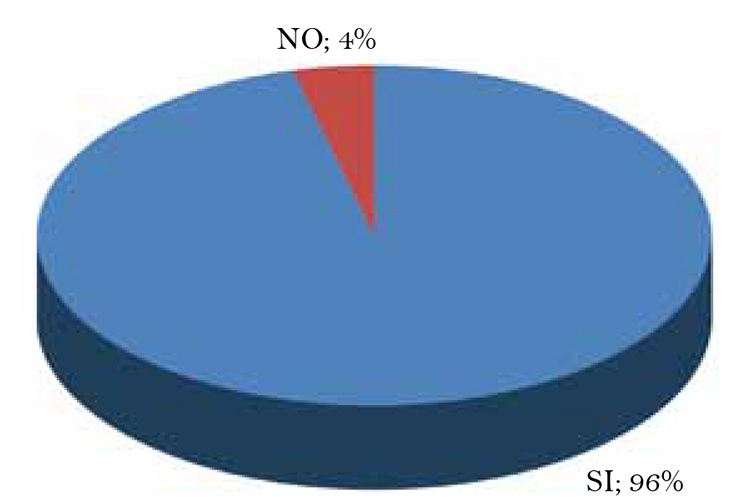Knowledge of the community about risk and skin cancer in a municipality of Santander
Keywords:
Skin neoplasms, risk factors, sunlight, prevention and control, nevus (MESH)Abstract
Background: Non melanoma skin cancer is the most common cancer; it has a low mortality but significant morbidity. One of the pillars in the management of skin cancer is primary prevention, as the main risk factor is solar ultraviolet radiation. Preventive campaigns have been done on this subject but people’s knowledge is unknown.
Methods: A health day was done in October 2009 in a town of Santander, in order to give care to patients of different specialties, among them, dermatology. Besides medical consultation, a written exam was performed to assess knowledge about skin cancer.
Results: Attention was given to 64 patients, 70% female (n = 45) and 30% male (n = 19), with a predominance of adults in both sexes. Dermatomycoses and actinic keratoses were the most frequent diagnosis, followed by nevus, acne and basal cell carcinoma on the face. The survey of 115 people responded, 96% (n = 110) knew of skin cancer. Of these 55% felt that skin cancer is very common; 25%, frequently; 16%, rarely, and 4% did not know there was skin cancer. 80% mentioned that occurs in both sexes considered 11% more common in women, 5% in men. 4% did not know. 59.2% thought that occurs at any age and 24.4% believe that only affects adults. 86.1% considered the sun as the most common risk factor. 45.2% think that the most common complication of skin cancer is death, 19.1% do not know of other complications and consider the deterioration of the skin, pigmentation and deformity in the aftermath of cancer. 62.7% considered the sunscreen as the most important way to prevent this, 17.4% attending physician assumes that prevents its presentation, and 9% do not know how to preventable skin cancer.
Author Biographies
María Claudia Guzmán
Médica, residente de segundo año de Dermatología, Universidad Autónoma de Bucaramanga, Bucaramanga, Colombia.
Vanessa Torres
Médica, residente de segundo año de Dermatología, Universidad Autónoma de Bucaramanga, Bucaramanga, Colombia.
Leyla Reyes
Médica interna, rotación especial de Dermatología, Universidad Autónoma de Bucaramanga, Bucaramanga, Colombia.
Ricardo Flaminio Rojas
Médico dermatólogo, docente, Universidad Autónoma de Bucaramanga, Bucaramanga, Colombia
Hernando Mosquera
Médico dermatólogo; jefe del programa, Universidad Autónoma de Bucaramanga, Bucaramanga, Colombia.
References
2. Uribe CJ, Meza EE. Incidencia de cáncer en el área metropolitana de Bucaramanga, 2000-2004. MedUNAB. 2007;10:147-72.
3. Rodríguez LA, Hormiga CM. Análisis de las enfermedades neoplásicas en Santander. Revista del Observatorio de Salud Pública de Santander. 2006;2:4-30.
4. Stockfleth E, Surber C, Ulrich C. Advances in the management of UVR-induced skin cancer. Br J Dermatol. 2009;161(Suppl.3):1-2.
5. Ministerio de Tecnologías de la Información y las comunicaciones – programa gobierno en Línea. Guadalupe. Fecha de consulta: julio de 2010. Disponible en: http://www.guadalupe-santander.gov.co.
6. Uribe C, Meza E, Ávila A. Epidemiología del carcinoma basocelular. Análisis de 1.423 casos observados en la población del área metropolitana de Bucaramanga. Rev Asoc Colomb Dermatol. 2007;15:275-9.
7. Aalborg A, Morelli JG, Mokrohisky ST, Asdigian NL, Byers TE, Delavalle RP, et al. Tanning and increased nevus development in very-light-skinned children without red hair. Arch Dermatol. 2009;145:989-96.
8. MacKie RM, Hauschild A, Eggermont AMM. Epidemiology of invasive cutaneous melanoma. Ann Oncol. 2009;20(Suppl.6):1-7.
9. Veierod MB, Weiderpass E, Thorn M, Hansson J, Lund E, Armstrong B, et al. A prospective study of pigmentation, sun exposure, and risk of cutaneous malignant melanoma in women. J Natl Cancer Inst. 2003;95:1530-9.
10. Mocellin S, Verdi D, Nitti D. DNA repair gene polymorphisms and risk of cutaneous melanoma: A systematic review and meta-analysis. Carcinogenesis. 2009;30:1735-43.
11. Ruiz A, Kuznitzky R, Garay I, Ducasse C, Albertini R. Factores de riesgo para carcinoma basocelular. Estudio de casos y controles en Córdoba. Medicina. 2005;65:495-500.
12. Burke KE, Wei H. Synergistic damage by UVA radiation and pollutants. Toxicol Ind Health. 2009;25:219-24.
13. Acosta A, Rueda X, Alba C, Pulido L. Guías de práctica clínica para el tratamiento del carcinoma escamocelular. Rev Asoc Colomb Dermatol. 2008;16:116-34.
14. Applebaum KM, Nelson HH, Zens MS, Stukel TA, Spencer SK, Karagas MR. Oral contraceptives: A risk factor for squamous cell carcinoma? J Invest Dermatol. 2009;129:2760-5. 1
5. Heinzerling LM, Dummer R, Panizzon RG, Bloch PH, Barbezat R, Burg G. Prevention campaign against skin cancer. Dermatology. 2002;205:229-33.
16. Staples M, Elwood M, Burton R, Williams J, Marks R, Giles G. Non-melanoma skin cancer in Australia: The 2002 national survey and trends since 1985. Med J Aust. 2006;184:6-10.
How to Cite
Downloads

Downloads
Published
How to Cite
Issue
Section
| Article metrics | |
|---|---|
| Abstract views | |
| Galley vies | |
| PDF Views | |
| HTML views | |
| Other views | |






